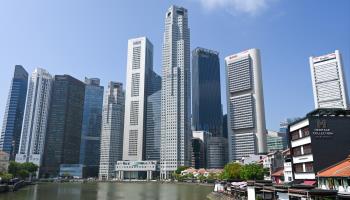The city-state is increasingly wary of the threat posed by heightened competition between the major powers
The Ministry of Foreign Affairs (MFA) notably said last month that Singapore’s foreign policy must “adapt swiftly” to realities including “sharper major power rivalry”. Increased US-Chinese tensions are unfavourable for trade-dependent Singapore because they undermine regional stability and disrupt global trade. Singapore is a close strategic partner of the United States and has extensive economic ties with China.
What’s next
Singapore will not choose between the United States and China but will rather seek to consolidate relations with both countries. The city-state will work with like-minded countries to buttress the international rules-based order and promote closer regional economic integration. It will also upgrade its armed forces in response to great power competition.
Subsidiary Impacts
- Singapore will remain reliant on the United States and Europe for advanced weapons systems.
- The city-state’s military will continue to use army training facilities in Taiwan, even at the risk of irking China.
- Regional businesses will benefit when Singapore champions deeper economic integration during its chairmanship of ASEAN in 2027.
Analysis
The MFA’s comments came in an addendum, published on September 15, to the president’s address at the opening of the 15th parliament earlier in the month.
US-Chinese competition
Growing rivalry between the United States and China, and US President Donald Trump’s transactional approach to foreign relations, are damaging to Singapore’s strategic and economic interests.
Since independence in 1965, Singapore has benefited from the US-led rules-based international order, globalisation, the proliferation of multilateral organisations and a stable global balance of power, but the MFA addendum describes the world as transitioning from “the post-Cold War order” to “a more uncertain era”. In addition to increased rivalry between the major powers, it says this includes “disruptions to global trade”, “weaponisation of economic tools”, “weakening multilateralism”, “rapid technological change” and “rising risks of conflicts”.
Singapore seemingly believes that the United States is no longer willing to underwrite the global order and has weaponised trade. The Trump administration has imposed 10% tariffs on imports from Singapore as part of its ‘reciprocal’ tariff scheme, even though the city-state had a trade deficit with the United States in 2024 (see SOUTH-EAST ASIA: Tariffs change US and Chinese ties – August 8, 2025).
However, even if the United States has stepped back from its role of guarantor of the world order, it does not mean that China is either willing or able to fill the vacuum. Instead, this order will likely be multipolar, with multiple power centres.
The emerging international order looks set to be unfavourable to Singapore. The city-state is highly dependent on global commerce, with a trade-to-GDP ratio of more than 300%. Moreover, it is a major trans-shipment hub, ranking as the second-busiest container port in 2024 after Shanghai.
Greater protectionism would depress trade, raise production costs and reduce economic growth.
Meanwhile, a conflict between the United States and China over Taiwan would be particularly damaging to Singapore. The United States is the largest source of foreign direct investment (FDI) in Singapore, and Singapore is among the top sources of FDI in China.
Working with like-minded states
As a small country of only around 6 million people, Singapore is especially committed to the free flow of goods, capital and ideas, and to a multidirectional foreign policy.
The city-state will intensify cooperation with like-minded middle and small powers in a bid to shore up the rules-based order.
Additionally, it will champion more extensive regional economic integration through ASEAN and trade pacts such as the Regional Comprehensive Economic Partnership (RCEP) and the Comprehensive and Progressive Agreement for Trans-Pacific Partnership (CPTPP). The 15-member RCEP includes all ten ASEAN countries, while the twelve-member CPTPP features four, including Singapore.
Singapore will expand its engagement with traditional partners such as Australia, New Zealand, Japan, South Korea and India, and will foster closer relations with countries in Central Asia, Africa and Latin America. Yesterday, during a visit by Prime Minister Lawrence Wong to Australia, Wong and Australian counterpart Anthony Albanese announced the launch of an enhanced version of the comprehensive strategic partnership that Singapore and Australia established in 2015.
With the help of partners, Singapore will seek a more effective UN
At the UN, Singapore will work with some of the other member states to improve the organisation’s effectiveness. A key focus will be reform of the veto system at the UN Security Council.
Strengthening the military
To meet the challenges posed by a more complex and contested security environment, Singapore will reinforce the central pillars of its defence policy and remain committed to maintaining the most advanced armed forces in South-east Asia, with military capabilities that exceed those of its neighbours.
Singapore will boost security ties with its traditional defence partners, including the United States, Australia, New Zealand, France, Germany and the United Kingdom. This will mean more frequent bilateral and multilateral military exercises and more collaboration regarding intelligence-sharing and defence manufacturing.
However, the city-state will not establish a formal military alliance with the United States or any other country, as it wants to preserve its strategic autonomy. To enhance its self-reliance in defence, the government will pursue measures to strengthen National Service, in which male citizens and permanent residents aged over 18 serve 24 months.
Singapore will not establish any formal alliances
The government has announced measures to upgrade the capabilities of the Singapore Armed Forces (SAF). The budget for fiscal year 2025/26 (April-March) earmarked defence spending of SGD23.4bn (USD18.1bn), 12.4% higher than the revised estimate for 2024/25, and the SAF should benefit from various new acquisitions (see SOUTH-EAST ASIA: Military modernisation will intensify – May 28, 2025).
In May, the government ordered two additional Invincible-class attack submarines from Germany. This will increase the submarine fleet to six vessels by around 2034 (two are currently operational).
In September, Singapore ordered four Boeing P-8A Poseidon maritime patrol aircraft to replace its fleet of Fokker 50 aircraft acquired in 1993. The Poseidons are designed to locate, track and — if necessary — destroy enemy submarines.
The Invincible-class boats and the P-8A Poseidons will help secure Singapore’s sea-lanes and protect the country’s sea-borne trade.
During a visit to the United States last month, Defence Minister Chan Chun Sing reaffirmed the government’s commitment to acquiring the Lockheed Martin F-35 Lightning II fighter aircraft. Singapore has twelve short take-off and vertical landing F-35Bs and eight conventional take-off and landing F-35As on order. When it receives its first four F-35Bs in 2026, it will be the only country in South-east Asia to operate fifth-generation stealth fighters (the other eight F-35Bs are scheduled for delivery in 2028 and the F-35As by about 2030).
The army will acquire new Titan infantry fighting vehicles and upgraded rockets for its High Mobility Artillery Rocket System. However, Singapore currently has no plans to acquire supersonic cruise missiles or short-range ballistic missiles.
The navy will soon launch a class of multi-role combat vessels that will serve as motherships for unmanned aerial, surface and subsurface platforms.
Drawing on lessons from the Russia-Ukraine war, the SAF will acquire more drones and counter-drone capabilities. Furthermore, Singapore has bolstered its cyber defences by launching two new commands to improve digitalisation and protect against cyber threats.
More broadly, the government aims to deepen the population’s understanding of the changing external environment to prepare it for the challenges of a less orderly and increasingly unpredictable global order.



